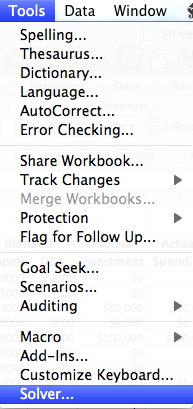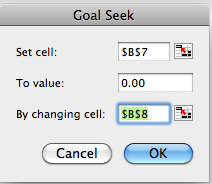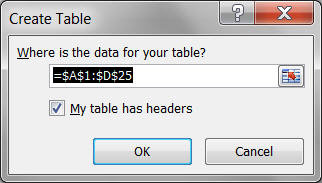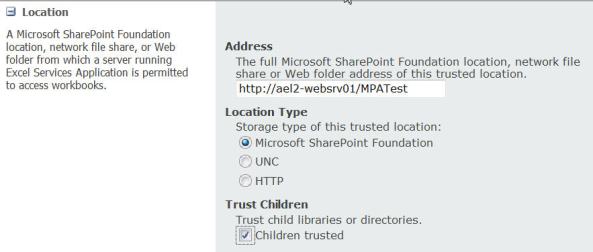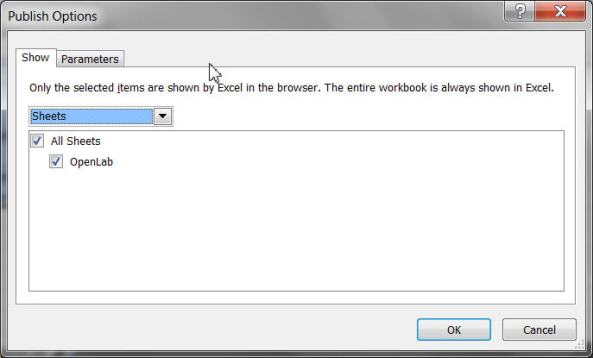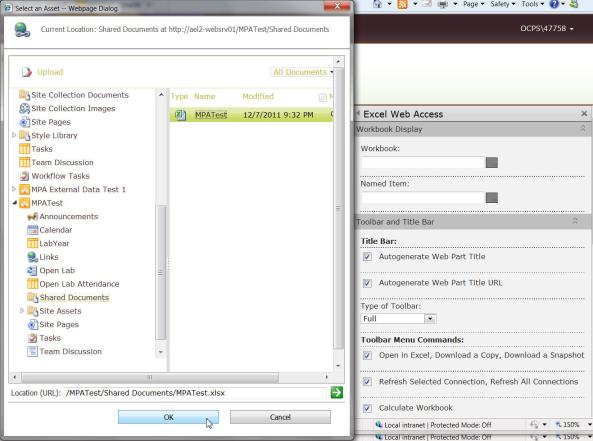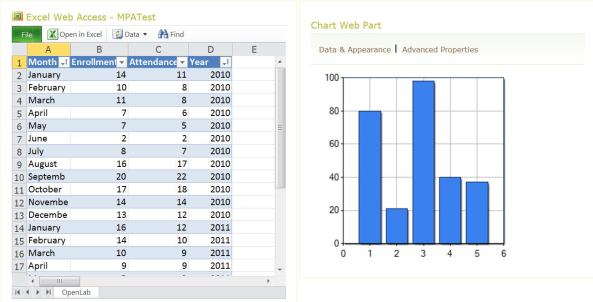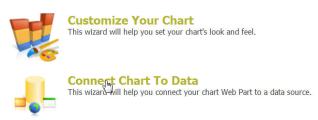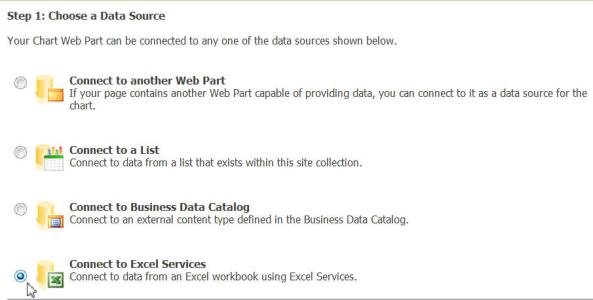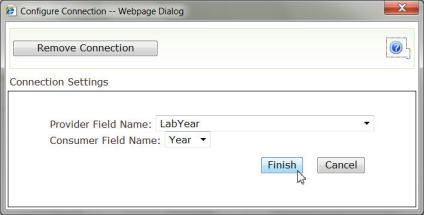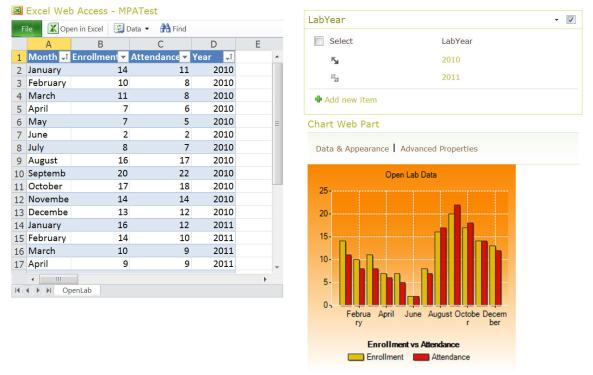Normally when you create a new document library, you get to choose from a list of available document templates that will become the default document type when the user clicks the New Document option in the Document ribbon. While you can set the document type in the Advanced Settings of the Library Settings option group, you can only select one document type as shown in the following image.
In this case a Microsoft Word document was selected as the default content type for new documents. This does not mean that the![]() user is limited to only storing Microsoft Word documents in this library. In fact, they can store Microsoft Excel documents, MS Project files, MS Publisher files and even MS PowerPoint presentations files. The image to the right shows the range of possible default content types you can assign to the library when creating it.
user is limited to only storing Microsoft Word documents in this library. In fact, they can store Microsoft Excel documents, MS Project files, MS Publisher files and even MS PowerPoint presentations files. The image to the right shows the range of possible default content types you can assign to the library when creating it.
Of course you can also save generic text files, PDF files and just about any other type of file in the library as long as the file is uploaded to the library rather than created from within the library. That means a lot of extra steps that many users may not be comfortable with. For example, to create an Excel spreadsheet file, they would first have to open Excel on their local desktop or laptop computer and create a new Excel file. Then to save the file in the SharePoint library, they might first save the file locally before going into the desired SharePoint library and uploading the document to the library. Some users might even know that they can save directly to SharePoint from the Excel Save dialog by first entering the URL for the site in the File Name text box, clicking Open, and then selecting the library where they want to save the file. In either case, both options require a few additional steps compared to the ability to directly create a Word document in the library.
![]() So you might ask whether there is a way to have more than one content type available from the New Document dropdown which initially only shows the type: New Document which is actually a MS Word document?
So you might ask whether there is a way to have more than one content type available from the New Document dropdown which initially only shows the type: New Document which is actually a MS Word document?
The quick answer is Yes. However, it may require a few steps that you may not intuitively figure out. So let’s go through the steps of adding an Excel Spreadsheet content types to a sample document library.
First you must you must create the blank Excel template file. To do this, open Excel but do not type anything in the spreadsheet. (Of course if you wanted to create a predefined Excel form for people to fill in, you could create the entire Excel spreadsheet and lock all the cells except for the cells where you want users to enter data.) Then open the File menu and select Save As. In the Save As Type dropdown, select Excel Template as the file type rather than just Excel. Give the template a name such as: Excel Template and save it to a location where you can find it later.![]()
Next, return to SharePoint and navigate to the site where you want to create the library, and if the library does not already exist, create a new library. You can leave the Microsoft Word document as the default content type. After creating the library, select Site Settings from the Site Actions dropdown.
On the Site Settings page, SharePoint groups the available options under different headers. Find the header: Galleries. Within this header, click on the option: Site content types as shown below.
The page that appears shows all of the content types currently defined. You can scan through the list to see if anyone else may have created a content type for the other Microsoft Office applications, but chances are they have not. Therefore, you can click on the Create link at the top of the page to begin the definition of a new content type.
![]() The dialog that appears next asks for some general information about the template including the template name and description. Remember that SharePoint shows this information to the user when they select the New Document dropdown so you want to make this information brief but informative. For the purpose of this example, I will simply use Excel Template for both.
The dialog that appears next asks for some general information about the template including the template name and description. Remember that SharePoint shows this information to the user when they select the New Document dropdown so you want to make this information brief but informative. For the purpose of this example, I will simply use Excel Template for both.
Next you need to select a parent content type. In this case, choosing Document from the Document Content Types group is the most similar content type from the available list. This selection defines some of the metadata that SharePoint automatically makes available to the new content type. In this case, the only visible metadata column (by default) is the Title column for the document. For most Microsoft Office documents, this selection will suit our default needs. You can go back after creating the content type and add more metadata columns to the content type.
You also have to assign the new content type to a content type group primarily to make it easier for users to find it. Because this example is all about creating additional Microsoft Office content types, I will opt to create a new group named Microsoft Office documents.
![]() After clicking OK, you will see another settings page similar to the settings page for the library. However, this is the settings page for the content type. Under the Settings group, click on Advanced Settings. Just as with libraries, the dialog from this option has a property that you can set to define the template used by this content type.
After clicking OK, you will see another settings page similar to the settings page for the library. However, this is the settings page for the content type. Under the Settings group, click on Advanced Settings. Just as with libraries, the dialog from this option has a property that you can set to define the template used by this content type.
Just as with libraries, the dialog from this option has a property that you can set to define the template used by this content type. Click the radio (option) button to Upload a new document template. You can directly enter the path for the template from your local computer or you can click the Browse button. I prefer using the Browse button just to be sure that I do not spell anything part of the document path incorrectly. You can choose to lock the content type so that it is read only for most users. You can also determine whether you want the uploaded content type to automatically update any site or list content types that may use this content type. When first creating a new content type, this setting does not really matter. However, if you later go back to edit an existing template with a new version it determines whether existing documents that use the template are also updated with the new template. If you have several libraries that use this content type or the libraries have many documents instantiated with the template, this could take some time. Therefore, try to get the template as close to being final as possible before loading it into a content type in SharePoint.
When you click OK, you now have a new content type that can be used anywhere on the current or child site in any library. However, before you can use it, you must do one more thing to the library.
Navigate to the library where you want to use the new content type and select Library Settings from the Library ribbon. In the resulting settings page, choose Yes to Allow management of content types in the Content Types group of options.
Then when you return to the general library settings page, you will see a new section named Content Types above the section that defines the columns used in the library. Click the link Add from existing site content types just below the content types list.
In the resulting dialog, select the Microsoft Office Documents group in the first dropdown. Remember I said that this would be a way to group your new content types. As the figure below shows, this group currently only contains one content type, Excel Template. Select it and click the Add button to add this content type to the current libraries available content types. Then click OK.
Returning to the Library Settings page, you now see two items in the Content Types. The default Document content type and the new Excel Template content type. The Microsoft Word document type is the default content type. However, you can change this to the Excel Template if you want to by selecting the link: Change new button order and default content type. For this example, I’ll leave the Microsoft Word document as the default content type.
Now when you return to the library list itself and select the lower portion of the New Document button from the Documents ribbon, you see two entries. The first entry is the original Word Document and the second is the Excel Template. (Notice the use of the name and description used match what we defined for these fields when we created the content type definition.)
But you don’t need to stop there. You can create template files for most of the applications in Microsoft Office that are document based such as Publisher, PowerPoint, and Project and going through the same steps as above, create content types for each of them. When creating your templates, you might consider applying a standard style used by your organization to the template so that all user documents will automatically inherit that style.
Now when the user opens this library, they can directly create any of these content types opening the appropriate Microsoft Office application to begin editing from the template.
You can even create blank forms in Microsoft Word and Excel that when published allow the user to open a new document and just begin filling in the form before saving it back to the library as a regular document with their data in it.





